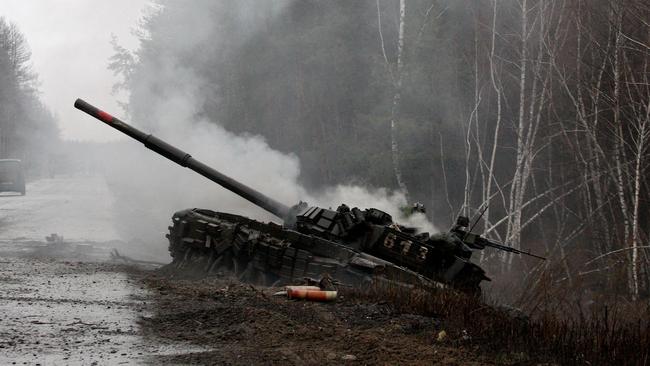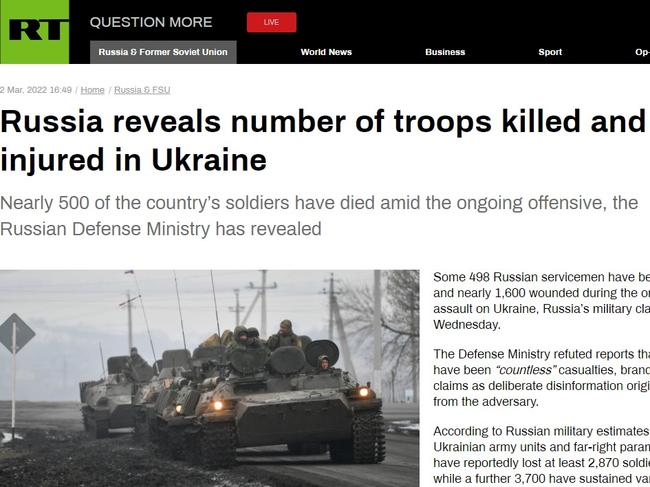Russia Today, Channel One: Russia’s insane lengths to censor Ukraine invasion
From banning the word “war”, to mismatched casualty figures and reports of “fake” footage, cracks are showing in Russia’s attempt to control public opinion.
World
Don't miss out on the headlines from World. Followed categories will be added to My News.
As Russia’s invasion into Ukraine enters its eighth day, the coverage of the war – or in Vladimir Putin’s mind, a peacekeeping mission – appears to vary greatly according to Russian sources.
Factual inconsistencies and censorship have been reported through the country’s state-owned media like Russia Today, Channel One and Sputnik, with jarring discrepancies between casualties and the military’s progress in Ukraine.
‘Cannot be described as anything but fake’
While Russia’s media landscape offers a mix of state-controlled and independent publications, Moscow has forbidden media to describe the Ukraine invasion as war, opting for the term “special operation” instead.

Non-government affiliated site The Moscow Times reports that “Russia’s media watchdog has ordered the country’s media to use only official sources” when covering the Ukrainian invasion.
Those who refuse to comply could be blocked within Russia or fined up to five million roubles, or the equivalent of $66,700.
In a report from the BBC, packages from Russia’s most watched channels, Rossiya 1 and Channel One also reveal discrepancies.
In one bulletin, a presenter warns viewers against images of destroyed Russian tanks, calling them “unsophisticated virtual manipulations”.
“Footage continues to be circulated on the internet which cannot be described as anything but fake,” they say.

Instances of Ukrainian forces committing war crimes and instigating attacks again civilians are also common.
“They use civilians as a human shield, deliberately positioning strike systems in residential areas and stepping up the shelling of cities in Donbas,” reads another report from Rossiya 1.
However, with access to social media platforms like TikTok, Twitter and Facebook, and international news sites, the push towards independent media channels is also increasing.
On Tuesday, the BBC reported that Russian visitors to its Russian language news site had tripled year-to-year, reaching a record 10.7 million visits in the past week.
Russian visitors to the English-based BBC.com also increased by 252 per cent, with 423,000 visits made in the period between February 21 to 27.
Russia moves to censor war
This comes as Russia’s communications regulator attempted to remove an entry detailing the Ukraine invasion from Wikipedia.
Government body Roskomnadzor sent a notification from the Prosecutor General’s Office threatening to block Wikipedia for the article “Russia’s Invasion of Ukraine (2022)”.
A tweet from Wikipedia’s Russian-arm showed a notification from the Prosecutor General’s Office and accused the site of “illegally distributed information”. It also complained of “reports about numerous casualties among service personnel of the Russian Federation and also the civilian population of Ukraine, including children”.
РоÑкомнадзор приÑлал уведомление от Генпрокуратуры Ñ ÑƒÐ³Ñ€Ð¾Ð·Ð¾Ð¹ блокировки Википедии за Ñтатью «Вторжение РоÑÑии на Украину (2022)». pic.twitter.com/O3vKd7H1GV
— РуÑÑÐºÐ°Ñ Ð’Ð¸ÐºÐ¸Ð¿ÐµÐ´Ð¸Ñ (@ru_wikipedia) March 1, 2022
However, in an effort to prevent misinformation, social media platforms have also taken actions against Russia’s state media.
Video-streaming service YouTube has removed thousands of videos from state-controlled sites RT and Sputnik and blocked hundreds of accounts and channels.
While Meta has not banned access to Facebook and Instagram in Russia, they have made moves to identify content from state-owned media outlets through pop-up warnings. Accounts linked to the state have also been banned from advertising and monetising their content.
1/ We are now prohibiting Russian state media from running ads or monetizing on our platform anywhere in the world. We also continue to apply labels to additional Russian state media. These changes have already begun rolling out and will continue into the weekend.
— Nathaniel Gleicher (@ngleicher) February 26, 2022
In response, the Russian government has also restricted the use of Facebook, after orders to lift restrictions went unheeded.
Meta’s head of global affairs, Nick Clegg, said authorities ordered the social media giant to “stop the independent fact-checking and labelling of content posted to Facebook by four Russian state-owned media organisations”.
“We refused. As a result, they have announced they will be restricting the use of our services,” Mr Clegg wrote on Twitter.
Mismatched numbers
Discrepancies between reported Russian and Ukrainian deaths are also frequent.
While military and civilian deaths have yet to be independently verified for either side – The New York Times reports Pentagon officials estimate military deaths to sit around 1500 for both countries – the reported figures differ greatly.
An article shared on March 2 by Russia Today stated that “some 498 Russian servicemen have been killed and nearly 1600 wounded during the ongoing assault on Ukraine”. Meanwhile, figures from Ukrainian ministries place Russian casualties to be over 5300.
Acknowledging the difference in figures, the article simply noted that “official casualty figures announced by Moscow differ drastically from the claims voiced by Kiev”.

Reports on Ukrainian casualties also vary.
“According to Russian military estimates, Ukrainian army units and far-right paramilitaries have reportedly lost at least 2870 soldiers, while a further 3700 have sustained various wounds,” Russia Today claims.
While the Ukrainian government has yet to release numbers on its military deaths, initial figures from the UN revealed at least 136 civilians, including 13 children have been killed, with a further 400 injured. However, a spokesperson for the UN’s Office of the High Commissioner for Human Rights said “the real toll is likely to be much higher”.
Russia denies using conscripted soldiers
In another example of competing facts, the Russian government has also denied sending conscripted soldiers into battle, despite several reports suggesting otherwise.
Under Russian law, all male citizens aged 18 to 27 must serve two years in the military, conscription also used as punishment against vocal activists. France 24 reports that up to 250,000 men are pulled into the military through this method.
According to Al Jazeera, a spokesman for Russia’s Ministry of Defence has also rejected claims that conscripts and cadets have been sent to Ukraine, something which has been contradicted by multiple sources.
Another report from a senior US Defence official reiterated claims that Russian conscripts were sent into Ukraine unknowingly.
“They’ve got, a lot of these soldiers are conscripts, never been in combat before, some of whom we believe weren’t even told they were going to be in combat,” said the unnamed official, speaking to CNN.
Here's a transcript of a Russian soldier's last text messages to his mother that Ukraine's Ambassador to the UN just read out from screenshots at the emergency session of the UN General Assembly pic.twitter.com/j8fTAz3xwr
— Vera Bergengruen (@VeraMBergen) February 28, 2022
Texts between a killed Russian conscript and his mother also suggested that some Russian troops were unaware of the severity of the invasion – something President Vladamir Putin himself has called a “peacekeeping” mission.
Speaking to the UN General Assembly on Monday, Ukraine’s ambassador to the UN Sergiy Kyslytsya shared a screenshot of the messages.
“Mama, I’m no longer in Crimea – I’m not in training sessions,” the soldier reportedly wrote in the texts.
“Mama, I’m in Ukraine. There is a real war raging here. I’m afraid. We are bombing all of the cities together, even targeting civilians. We were told that they would welcome us. They are falling under our armoured vehicles, throwing themselves under the wheels and not allowing us to pass. They call us fascists. Mama, this is so hard.”
Jess Wang | jessica.wang@news.com.au
Originally published as Russia Today, Channel One: Russia’s insane lengths to censor Ukraine invasion





